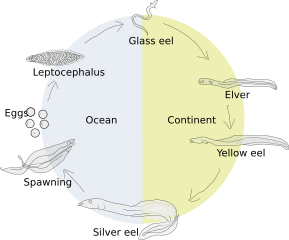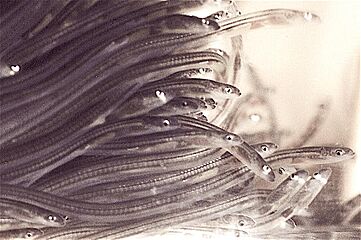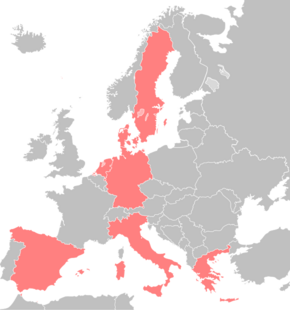European eel facts for kids
Quick facts for kids European eel |
|
|---|---|
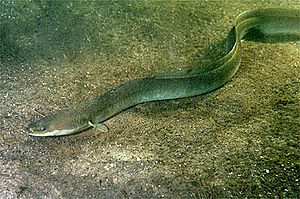 |
|
| Conservation status | |
| Scientific classification | |
| Genus: |
Anguilla
|
| Species: |
anguilla
|
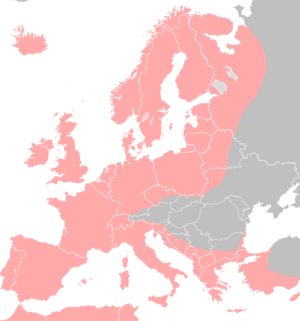 |
|
| Freshwater range of wild European eel | |
| Synonyms | |
|
Muraena anguilla Linnaeus, 1758 |
|
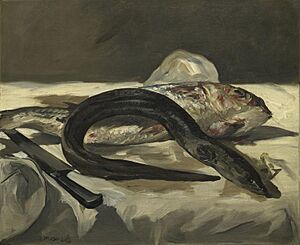
The European eel (Anguilla anguilla) is a special type of eel. These amazing fish are now in serious trouble. Their numbers have dropped a lot, making them a critically endangered species. This means they are at a very high risk of disappearing forever.
Many things are causing their decline. These include hydroelectric dams that block their journeys, too much overfishing by people, and tiny parasites that make them sick.
Contents
About European Eels
European eels are usually about 45 to 65 centimeters long. Sometimes, they can grow up to 1 meter, and in rare cases, even longer! They have between 110 and 120 bones in their spine.
In the wild, European eels typically live for about 15 to 20 years. But some eels kept in special places have lived for more than 80 years! One famous eel, called "the Brantevik Eel" in Sweden, lived for an incredible 155 years in a family's well.
Where Eels Live and What They Eat
Eels can be found from the surface of the water down to 700 meters deep. After they lay their eggs in the Sargasso Sea, baby eels travel north. They spread out across the Atlantic Ocean, its coasts, and the rivers that flow into it.
European eels mostly hunt for food at night, using their strong sense of smell. They eat worms, other fish (even big ones they have to bite chunks off), snails and slugs, crabs and crayfish, and sometimes tiny plankton when there's a lot of it.
Bigger eels, herons, cormorants, and pike like to eat European eels. Young eels, called elvers, can also be eaten by seagulls. Eels often hide in plants or in tube-shaped cracks in rocks to stay safe. When they are inland, they might even hide in muddy fields.
Why Eels Are in Danger
The European eel is a critically endangered species. This means their population has dropped dramatically. Since the 1970s, the number of eels reaching Europe has fallen by about 90%, and maybe even 98%.
Many things are causing this big drop:
- Overfishing: Too many eels are being caught by people.
- Parasites: Tiny creatures like Anguillicola crassus make eels sick.
- Dams: Hydroelectric dams block the eels' long journeys to and from the sea.
- Pollution: Chemicals like polychlorinated biphenyl (PCBs) might also be harming them.
Organizations like TRAFFIC are working to track and control the eel trade. This helps make sure eels are caught legally and sustainably. The species is also listed in Appendix II of the CITES Convention, which helps control their trade. Studies show that waters with large dams have almost twice as many fewer eels compared to waters without dams.
Eating Eels Sustainably
Eels have been an important food source for a long time. People eat adult eels, and also young eels called glass eels. Fishing for glass eels has been very important for the economy in many river areas along the western coast of Europe. The United States also imports a lot of eel for its sushi industry, including European eels.
To help protect eels, Greenpeace International added the European eel to its "seafood red list" in 2010. This list helps people know which seafood to avoid to protect ocean life. The Sustainable Eel Group also created a special standard to encourage sustainable eel fishing.
Breeding Projects for Eels
Because the European eel population has been falling, scientists have started projects to help them. In 1997, a group in the Netherlands tried to get eels to breed in captivity. They even built a special swimming machine to make the eels feel like they were making their long 6,500-kilometer journey to the Sargasso Sea.
Scientists at DTU Aqua in Denmark had some success in 2006. They managed to breed eels in tanks using a mix of fresh and salt water, along with hormones. The baby eels (larvae) survived for 4.5 days. By 2007, they set a new record, with larvae surviving for 12 days! They found that feeding the mother eel a special diet helped.
The baby eels need to eat after about 12 days. Scientists went on expeditions to the Sargasso Sea to find out what wild baby eels eat. They discovered that the larvae eat tiny planktonic organisms, especially microscopic jellyfish.
In 2010, a big project called PRO-EEL started, involving many research groups across Europe. By 2014, the eel larvae in their labs were surviving for 20 to 22 days. By 2022, they could survive for about 140 days, reaching the leptocephalus stage (just before they become glass eels). However, scientists still haven't been able to complete the full life cycle of the eel in captivity.
Life Cycle of the European Eel
For many years, the life story of the European eel was a big mystery. Fishermen never caught young eels that they could recognize. Unlike many other fish that migrate, eels start their lives in the ocean. They spend most of their lives in fresh water or salty coastal water. Then, they return to the ocean to lay their eggs and die.
In the early 1900s, a Danish scientist named Johannes Schmidt discovered that the Sargasso Sea was likely where European eels went to lay their eggs. The tiny baby eels, called leptocephali, then drift towards Europe on a journey that takes about 300 days.
When they get close to the European coast, these larvae change into a clear, see-through stage called "glass eels." They enter river mouths and many start swimming upstream into rivers. After entering their new homes, the glass eels change again into elvers, which look like tiny adult eels.
As the eel grows, it becomes known as a "yellow eel." This is because their sides and belly turn a brownish-yellow color. After living in fresh or salty water for 5 to 20 years, the eels become ready to have babies. Their eyes grow bigger, their sides turn silver, and their bellies become white. At this stage, they are called "silver eels."
Silver eels then begin their long journey back to the Sargasso Sea to lay their eggs. This "silvering" change is important because it helps them produce a hormone called cortisol. Cortisol helps them get energy for their long swim back to the sea. Another hormone, 11-Ketotestosterone, helps their skin change so they can handle moving from fresh water to salty ocean water.
Sometimes, an eel might never go into fresh water. It might stay in the ocean its whole life. Others grow up in salty water or travel between salty, brackish (a mix of fresh and salt), and fresh water many times.
Some studies suggest that European eels can sense the Earth's magnetic field. This ability, called Magnetoreception, might help them find their way during their long migrations.
Eel Farming and Industry
How Eels Are Farmed
The eel farming industry raises glass eels caught from the wild. They keep them in special pools for 8 months to 2 years until they are big enough to sell. Some farms also use special fences called weirs in coastal areas.
New eels are kept separate at first to stop diseases from spreading. Eels are sorted by size every few weeks to prevent them from eating each other and to remove any sick or dead ones. The best temperature for eels to grow is between 23°C and 28°C. They are fed pellets and pastes made of protein. Very small glass eels are first fed cod roe. Filters are very important to keep the water clean for the eels.
Eels are usually moved by road in tanks of water. For air travel, they are put in styrofoam boxes with ice. The ice keeps the air moist and cool, which helps the eels survive the trip.
Diseases in Eel Farms
Diseases can spread quickly in crowded eel farms. That's why it's important to keep new eels separate. Some common problems are "red fin" and "red eel pest."
- Red fin: The eel's tail and fins start to rot. A salt solution can help treat it.
- Red eel pest: This causes sores, swelling, and red spots on the skin. Antibiotics can treat it.
- Other bacteria like Aeromonas sobria can also infect eels, especially if they are stressed. These can be treated with medicines.
- Parasites: Tiny parasites can cause white spots, extra mucus, frayed fins, and make eels rub against their tank. They might also have trouble breathing or be very tired. Salt solutions or formaldehyde can treat these.
- Viral infections: "Red head" is a viral infection that causes red bleeding from the head. Vaccinations for young eels, salt solutions, or cooler water can help.
- Fungal infections: These can cause swollen gills and brown or white patches on the skin. Salt solutions can also treat these.
The Eel Industry
Since 2010, selling European Eels to other countries has been limited. Still, about 44% of eel sales in the United States are European eels. Eel farming, called aquaculture, is biggest in Japan. Other countries like China, Scandinavia, Europe, Australia, Morocco, and Taiwan also farm eels.
Unfortunately, human efforts to breed eels in captivity have not been fully successful yet. This means the entire eel industry still depends on eels breeding in the wild. This makes the industry unstable and vulnerable to all the problems that are making European Eels endangered.



